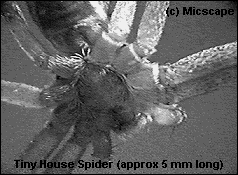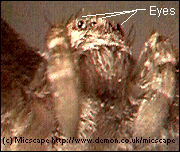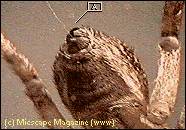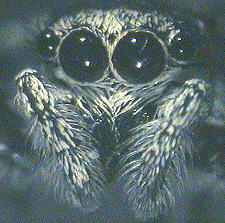

For some it is the thought of going to the dentist, for others it is spiders, injections, or the fear of madness or going blind. The microscope in its various disguises can help us examine these nightmares close-up. In this mini series, I will take you month by month, through some of our common nightmares. Did you think Microscopy was about quiet, studious, safe things? I hope not. 'Scoping' can take us nearer to beauty or closer to the savage truth of reality. For this month, let us consider our tiny house guest:-
Many people have an irrational fear of spiders. I used to suffer from arachnophobia - 'a fear of spiders', myself and I fully understand the terror of knowing that a tiny spider is in the same room as me. There was a time in my life when I could not go to bed at night without making a complete survey of my bedroom and frantically 'stamping' out the life of any spiders found. That was a long time ago and today I can normally pick up most house spiders with my hand and even let them run over my face and body! I taught myself to beat the fear over a period of years. Maybe I can help you overcome your fear the same way?
The first step to beating the fear of something is to learn more about the actual thing which frightens you. Although it is the middle of winter (as I write), I'll go and have a good look around my house to see if I can find a spider to show you. Hold on while I go and look...
Creak... rustle... patter... patter... clunk!!
 Yup, got one!
Found it in the bathroom. I'm afraid it's only a tiny little one
about 4-5 mm long but once I put it in a glass and turn my camera
on, you should see it clear enough. Right, I'll just coax it
around the glass to the light... there we go - one little spider
as seen from beneath:-
Yup, got one!
Found it in the bathroom. I'm afraid it's only a tiny little one
about 4-5 mm long but once I put it in a glass and turn my camera
on, you should see it clear enough. Right, I'll just coax it
around the glass to the light... there we go - one little spider
as seen from beneath:-
A bit fuzzy, but never mind. I'll show you some clearer images in a moment after I tell you a bit more about spiders in general. Don't go running out of the room yet. Stay with me, grit your teeth, and in a few minutes you might find these tiny creatures are a lot more attractive then you originally thought.
Spiders belong to a group of animals called arachnids. This family also contains mites, scorpions, ticks, and harvestmen. All of them have eight legs and are arthropods. There are over 32000 different known species of spiders, and most of them are able to inject poison into their prey, although extremely few of them are able to kill a human being. Even this little spider I just found in the bathroom has a bite which carries a powerful venom. Most spiders would not bite you anyway, simply because you are not food; although if you aggravated one long enough it might take a nip as a defensive move. Most of our household spiders in the UK are incapable of penetrating our tough skin so you have nothing real to fear from them. If you live in a tropical climate, I would be a bit more cautious: some of smallest spiders in warmer countries have the most poisonous bite!
Most spiders have eight eyes although some have none at all. Even the ones that can see do not get a very clear view of the world around them. It is almost certain that they are unable to see you. Of course, if one was walking on your skin, it would be able to see the surface it ran on. Sorry, didn't mean to make you cringe! Spiders rely more on their sense of smell and the their refined ability to detect vibrations. In fact some spiders are so poor at seeing, they are equipped with a special comb which they can rub to make a noise and signal their presence to a prospective mate. Often two 'love-birds' may only be a few centimetres from each other but would be unable to find each other without this sound-making and detection capability. Spiders also use chemical signals to identify themselves to each other during, or before, the mating ritual.
 At the front of
their bodies, spiders have a pair of pedipalps. These often look
like short legs. These are used in much the same way as insects
use antennae (or feelers) to help the spider find its way around.
Male spiders also store their sperm in the pedipalps for use
during mating rituals. You can see the pedipalps (out-of-focus)
in our little spider here. Also note some of the eight eyes at
the top of the head.
At the front of
their bodies, spiders have a pair of pedipalps. These often look
like short legs. These are used in much the same way as insects
use antennae (or feelers) to help the spider find its way around.
Male spiders also store their sperm in the pedipalps for use
during mating rituals. You can see the pedipalps (out-of-focus)
in our little spider here. Also note some of the eight eyes at
the top of the head.
 Spiders can spin
different types of silk using special glands inside their bodies
at the rear of the abdomen. They use 'dry' silk as safety threads
when climbing or when spinning cocoons to protect their eggs.
When they need to spin a web to trap flies and other insects, has
other glands to deposit a sticky substance along the thread as
fine droplets. The spider is aware of these points when
traversing its own web, and thereby avoids becoming trapped in
its own 'fishing net'. You can see my little spider in the glass
has spun some silk (A). It is interesting to
note that this single fine thread is stronger than a steel one of
the same diameter, and can be stretched to one and a third times
its length without breaking!
Spiders can spin
different types of silk using special glands inside their bodies
at the rear of the abdomen. They use 'dry' silk as safety threads
when climbing or when spinning cocoons to protect their eggs.
When they need to spin a web to trap flies and other insects, has
other glands to deposit a sticky substance along the thread as
fine droplets. The spider is aware of these points when
traversing its own web, and thereby avoids becoming trapped in
its own 'fishing net'. You can see my little spider in the glass
has spun some silk (A). It is interesting to
note that this single fine thread is stronger than a steel one of
the same diameter, and can be stretched to one and a third times
its length without breaking!
Young garden spiders can often be seen in the summer garden 'ballooning' : they attach a fine strand of silk to a plant leaf or stem and let the wind catch the thread to lift them up and carry them far away from their birth place. This technique has enabled the spider to populate many islands close to mainland, literally by ballooning across the sea.
The spider is really man's best friend. Imagine a world
over-run with flies. Life would be intolerable! Without our
friend the spider eating other insects like the fly, many serious
pests would rise in number and present humankind with an
incredible problem - one which would seriously affect our chances
of survival. Even the good old household spider, like the little
one I have here, does his part. Imagine how much it would cost to
develop tiny little robots to roam over your house and clean up
the maggots, eggs, flies, larva and other living things hidden
away in every crack and cranny throughout your home. The spider
does it all for you, and all for nothing. Most times he even has
the sense to stay out of the way when you are around. So if you
want to keep the real pests down, tolerate the spider a bit more
in your home. If you really cannot bear to have one in the room
with you, go and fetch a glass, pop it over the spider before he
runs for it, and slip a postcard or stiff bit of paper under the
glass to temporarily seal it in. You can then turn the glass
upright and with the card or paper still held on top, take it out
into the garden and let it go. One deft flick of the glass low to
the ground should do it.
It's happened to you too, eh? You have a long day at the office or at home with the kids, and decide to have a nice warm bath or shower to relax. But when you get to the bathroom, our little friend the spider has beaten you to it! Well it's no good keeping the plug in the bath. Contrary to popular myth, they don't come up the plug hole. The spider is unable to swim through the water trapped in the pipe. If you find a spider in the bath, it fell in there, probably from the ceiling, or while skirting around the edge. Please do not drown it - go and get the glass, and put it outside.
 I mentioned earlier that most
spiders have very poor eyesight. I thought before we leave this
month's nightmare, you might like to see one that has very good
eyesight, namely - the jumping spider. This one has a neat trick.
It creeps up on its prey until it can see it
quite clearly, then leaps onto it in spectacular fashion before
making a meal of it.
I mentioned earlier that most
spiders have very poor eyesight. I thought before we leave this
month's nightmare, you might like to see one that has very good
eyesight, namely - the jumping spider. This one has a neat trick.
It creeps up on its prey until it can see it
quite clearly, then leaps onto it in spectacular fashion before
making a meal of it.
That's it for this month. I'll go put the little spider back where I found it. Perhaps by the summer he may be big enough for me to rescue him from the bath and put out into the garden. Mind you, he'll only be big enough if he manages to find a few other pests hanging around the house.
Please report any Web problems
or offer general comments to the Micscape Editor,
via the contact on current Micscape Index.
Micscape is the on-line monthly
magazine of the Microscopy UK web
site at Microscopy-UK